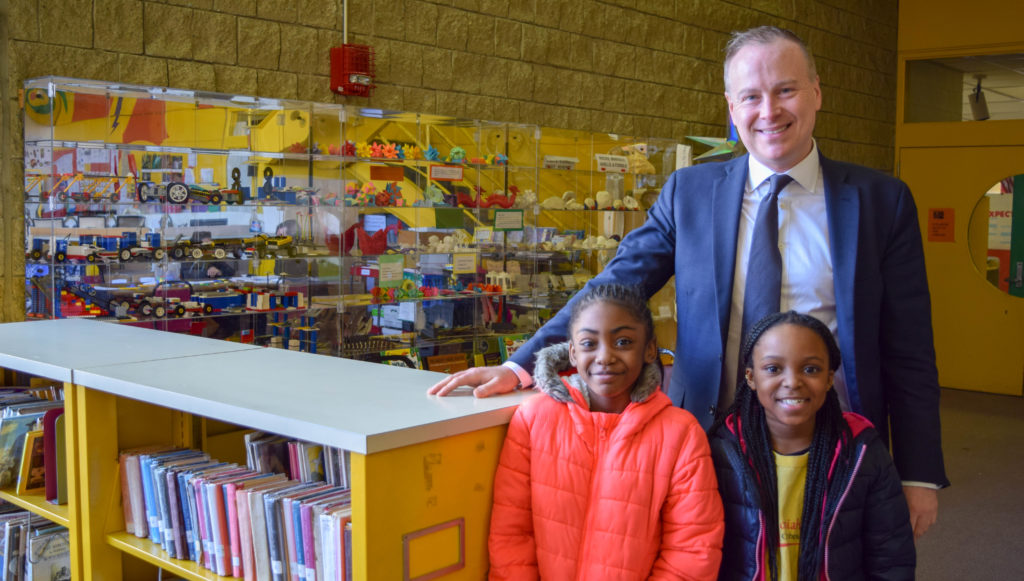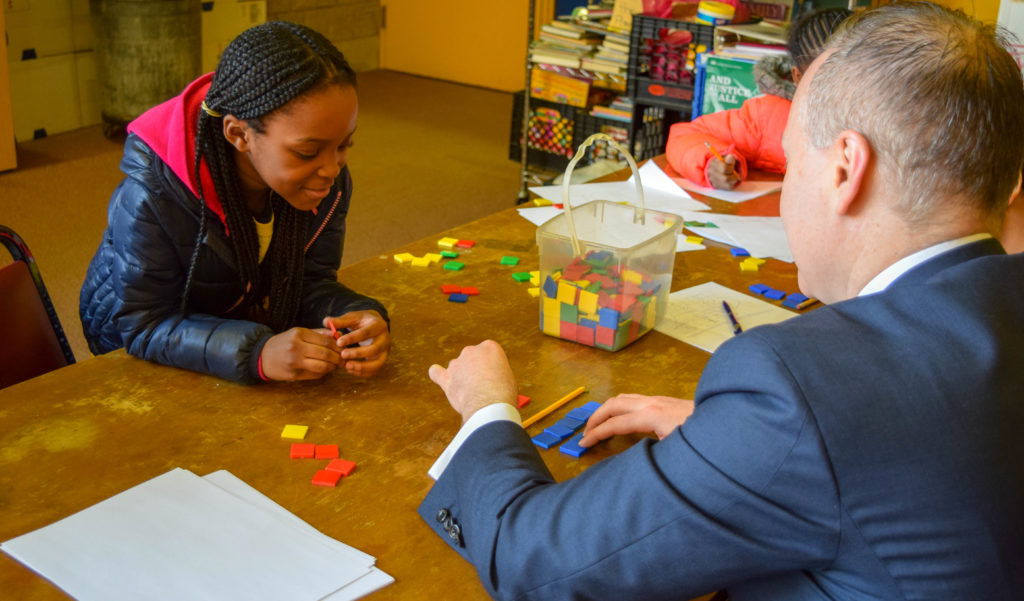
Grant Simpson’s students leap up with huge smiles as he enters their third grade classroom at the Josiah Quincy Elementary School in downtown Boston, in such excitement that one of them forgets to grab her workbook and pencil. In a few moments, the trio will follow Grant to the library to work on their math – today they are learning to multiply and divide fractions, and Grant will try to have the students prove to themselves that 1/5 divided by 2/10 equals one.
Grant came to Boston five years ago to live closer to his family, and has since started a real estate brokerage with his brother, Doors Residential Brokerage & Advisory. Almost as soon as he was settled, he was searching for opportunities to volunteer in public schools, and became connected with Boston Partners in Education.
“Everyone has a cause and everyone helps out in their own way. My mom was a middle school teacher for thirty five years. My cousin is an elementary school teacher. My aunt volunteered in her classroom after she retired. I went to a public school. And so there just came a time when I felt I needed to start helping,” says Grant, now in his third year as an academic mentor.
Part of Grant’s role as a mentor is to act not only as an academic guide, but also as an emotional one, though he has had to learn this through his experience. “At first — despite people telling me that just being there and communicating with students is more important than the actual subject matter — I dismissed that, misguidedly.”
Charla, Natasha, and Alijah look on intently while Grant places two colored tiles above his pencil, and five red colored tiles beneath. The library is a busy, bright yellow room with plenty of distractions as fellow students and teachers pass by, but the students remain focused on Grant. “Do you know what this is called?” he asks, pointing at the bottom tiles. The trio shake their heads. “The denominator,” says Grant.
Addressing Natasha, Grant asks what fraction is represented. Excitedly, Charla interjects:
“Two fifths!”
Natasha tugs at Grant’s shoulder.
“You said Charla’s goal was to interrupt less!”
“I did,” said Grant, holding back a laugh. Charla grins and apologizes.
“They will surprise you, sometimes with wit, sometimes absurdity, and it is fun as long as you can keep a light heart about it. They can be rambunctious but it’s a good rambunctious,” Grant later remarks.
Next to the fraction on the table, Grant makes another fraction with four green tiles above his pencil and ten green tiles below. He asks the girls to work out the problem. Charla gives a couple of guesses, but the answer eludes the three of them. Grant decides to tackle the problem a different way. Throughout his tenure as a mentor, Grant has come to understand his role as less of a teacher, and more of a facilitator for learning.
“It is a hard concept to grasp that you don’t know about something until you know about something. With some of these students it is almost like they have never known that they could do math, so the moment they realize they are capable of it, everything changes. It becomes a lot more fun because they want to interact.”
Grant shares a memory which informs how he approaches this year’s students, when a former group of girls discovered the concept of volume with only his minimal guidance. “A cube of blocks was put together and I took it all apart and asked the students to add them. Eventually they got to this point where they realized volume was side X side X side. They proved it to themselves by saying we have two on this side, two on this side, and two on this side. Then they broke the thing apart, counted the cubes and put them back together. No matter how they did it, it always came out to the same volume and they were blown away by this. It is this realization that we all take for granted.”
 Grant lifts up one of the green tiles and says, “Let’s say this green tile is worth five red tiles, like how a nickel equals five pennies. If I add a green tile up here, what do I need to add to the bottom?”
Grant lifts up one of the green tiles and says, “Let’s say this green tile is worth five red tiles, like how a nickel equals five pennies. If I add a green tile up here, what do I need to add to the bottom?”
“The denominator,” Natasha corrects him. “Right, the denominator,” says Grant, a big smile coming across his face. Grant’s favorite moments are when a student grasps a concept for the first time. “It is this moment where this lightbulb goes off in their head and they realize, ‘I now know how to do a square root. Six weeks ago, square root was some sort of plant, and now I can actually tell you what the square root of nine is and I can tell you why.’ It is just this instant in time,” Grant says, snapping his fingers in the air for emphasis.
“Add five,” says Charla.
“And if I do add two?”
“Add ten?” asks Alijah after a pause.
“And what happens if I take away three?” he says, removing three of the green tiles.
Natasha and Charla answer in unison, “Take away fifteen!”
This is a great example of moments which have become formative not just for the students, but for Grant, too.
“I eventually realized that the subject matter is completely secondary to them actually coming to the realization that this subject matter is within their realm of possibility. You go through this proof process where you are taking them step-by-step through particular math problems they never realized they could do. Then you can almost watch them get to this point where they can do it on their own and it is an entirely different interaction from then on out,” says Grant. It’s by this process that Grant has seen what makes in-school mentoring a unique and valuable addition to the Boston Public Schools.
“This is a very direct way to get involved with students and teachers. I had never been on this side of it until I started mentoring, and the expectations that are put on individual teachers are staggering. It feels good to ease that burden as best I can. Mr. Amara is fantastic too,” Grant adds in reference to the teacher he has worked with all three years. “He is incredibly diligent and thoughtful and helpful.”
Delighted with his students’ progress, Grant brings back his tiles to their original formation. “So what are these?” he asks, gesturing to the 1/5 and 2/10 representations on the table. Natasha’s eyes grow wide as she understands the problem for the first time. Charla says “They’re the same!”
“That’s great!” says Grant, clapping. “That’s a great spot to call it a day.”
After walking the trio back to class, Grant prepares to visit his second class of the day where he will mentor another group of students, but not before reflecting on the eventful morning. “That is what I look forward to the most — when they all work together because they are all kind of syncing, the three of them, and working on something they are enjoying. They are all kind of getting it, together. It is a lot of fun.”
Grant continues to be one of our organization’s most active supporters even after the school bell rings. In addition to volunteering in two classrooms, Grant makes time to serve as a member of our Board of Directors and participate in the Big Cheese Reads initiative, through which he visits middle school classrooms to talk about how literacy and learning have influenced his career.
“It is very simple. I so strongly believe in this cause and the effectiveness of the organization,” says Grant. “When you believe strongly in the organization it is actually super easy to say, ‘I’m doing this. I’m working for this organization, it is super effective, and I am just one of five hundred people.’”
